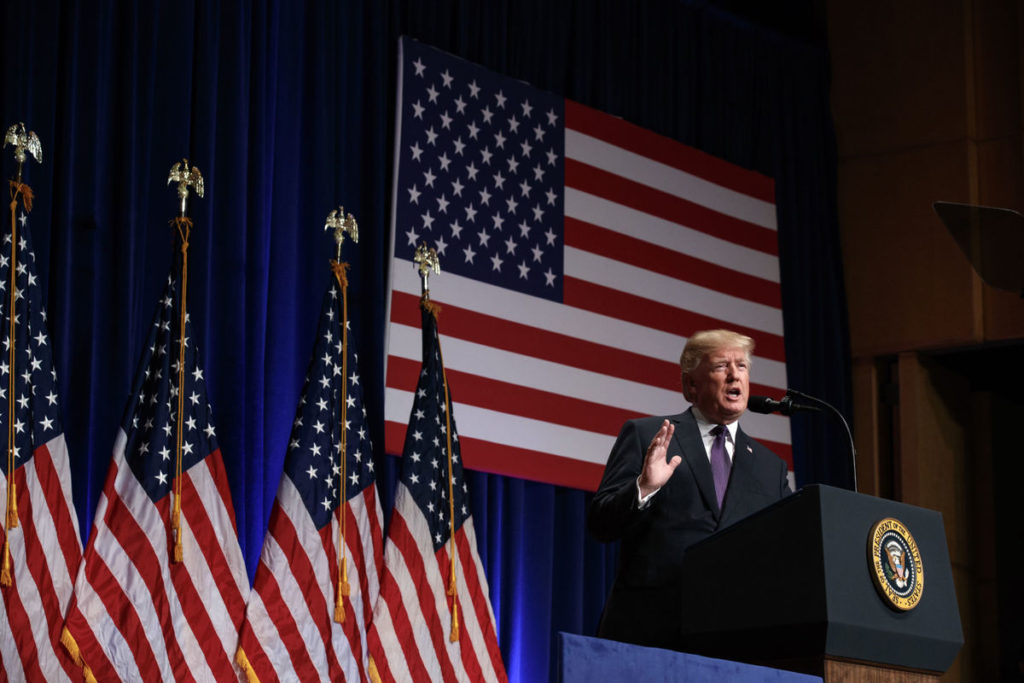President Donald Trump’s new national security strategy seeks to refocus the United States’ relationship with the rest of the world, transforming his “America First” mantra into a set of policies and plans for protecting the homeland and advancing its economy. The following items were outlined in his administration’s strategic document released Monday.
CENTRAL TENETS OF TRUMP’S BLUEPRINT:
— Fighting global threats: Trump says the U.S. must re-establish control of U.S. borders to block “jihadist terrorists” and international criminal groups, familiar themes from his campaign and first 11 months in the White House. North Korea and Iran are singled out as the leading threats to U.S. security, followed by what Trump used to call “radical Islamic terrorist” organizations like the Islamic State group and al-Qaida. The strategy emphasizes cyber threats and says the administration will assess such risks to security, energy, banking and transportation.
—Tough on trade: Whereas past administrations argued a prosperous global economy would benefit all countries, Trump’s strategy describes nations in fierce competition. It calls for fighting U.S. trade deficits by ensuring commercial relationships are fair, reciprocal and rules-based. It champions bilateral trade deals between the U.S. and individual countries, not the larger, multi-country deals President Barack Obama pursued.
—Bigger, better military: Trump’s strategy calls for increased defense spending to use the military as a force for peace. It includes familiar calls for the government to work more efficiently with industry to buy and build better, more high-tech weapons and end budget limits established in the midst of the recession. It also renews Trump’s for a modernized nuclear arsenal.
— A world that helps America: Trump’s vision holds that other nations in global alliances and international organizations need to pay in their fair share. For too long, the U.N. and international financial institutions have been taken advantage of, to America’s detriment, the strategy says. Such bodies should be “strengthened and supportive of the United States, our allies, and our partners.” It repeats Trump’s demand that NATO members spend more on defense.
—Combatting China: The strategy deems China, like Russia, to be a “revisionist” power, determined to reshape the world according to its own ideals. “Chinese dominance risks diminishing the sovereignty of many states” in its region and beyond, it says. The strategy calls for stronger traditional alliances and new partnerships in Asia amid a “geopolitical competition between free and repressive visions of world order.” One new policy proposed: Restricting visas to prevent intellectual property theft by foreigners, particularly Chinese, who travel to the U.S. to study science, engineering, math and technology.
—Countering Russia: The strategy is harsher on Russia than the president has been in public comments. It says Russia uses “subversive measures” to weaken America’s credibility and European governments, specifically calling out Moscow for “its invasions of Georgia and Ukraine.” The document doesn’t specifically mention Russia’s alleged meddling in last year’s U.S. presidential election. It does warn that Russia and China are more effectively using cyberattacks and online propaganda, saying the U.S. and allies must counter the misinformation.
—Ending the North Korean threat: The U.S. is ready to respond with “overwhelming force” to North Korean aggression and will “improve options” to compel the North to give up its nuclear weapons. However, the “options” aren’t entirely spelled out. It seeks cooperation from longtime allies Japan and South Korea toward an “area defense capability” — but that would surely be opposed by China. South Korea also says it has no intention of joining such a missile defense network. The strategy calls for building better defenses against ballistic missiles, potentially defeating such weapons prior to launch. It doesn’t say how that will be done, but could allude to cyber tools to disable or destroy key missile components.
—Dangers and opportunities nearby: The strategy warns about “violence, drug trafficking and illegal immigration” from Latin American nations, but it also floats great opportunity for U.S. investment and trade. It calls out Venezuela and Cuba for having what it calls “anachronistic leftist authoritarian models” that fail local populations. It says the U.S. will seek to counter such governments through “strong diplomatic engagement.”
—A Mideast beyond Israel: The strategy specifically rejects the Israeli-Palestinian conflict as central to Middle East instability. Instead, it identifies extremist groups like al-Qaida and IS, and Iran as prime catalysts. “Israel is not the cause of the region’s problems,” the document says, noting that once hostile countries are finding common ground with the Jewish state on security issues. The U.S. is promoting “gradual” change in repressive countries with extremism problems like Egypt and Saudi Arabia.
—Budding India alliance: The strategy promotes a deeper partnership with India. Pakistan, on the other hand, must crack down on “transnational terrorists” operating from its soil, it saysl. But the document offers Pakistan the carrot of greater trade and investment ties if it helps on counterterrorism. The regional approach could be part of the broader effort to counter China, which is investing billions in Pakistan. In Afghanistan, the U.S. will bolster the national army to “convince the Taliban that they cannot win on the battlefield.”
(AP)











